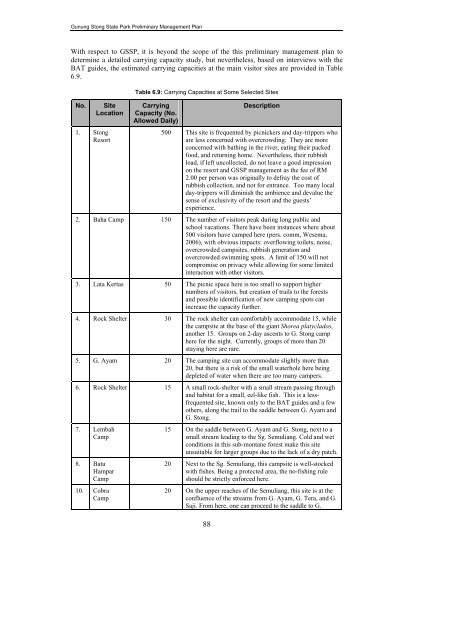FINAL VERSION FOR APPROVAL - Sdn Bhd - WWF Malaysia
FINAL VERSION FOR APPROVAL - Sdn Bhd - WWF Malaysia
FINAL VERSION FOR APPROVAL - Sdn Bhd - WWF Malaysia
You also want an ePaper? Increase the reach of your titles
YUMPU automatically turns print PDFs into web optimized ePapers that Google loves.
Gunung Stong State Park Preliminary Management Plan<br />
With respect to GSSP, it is beyond the scope of the this preliminary management plan to<br />
determine a detailed carrying capacity study, but nevertheless, based on interviews with the<br />
BAT guides, the estimated carrying capacities at the main visitor sites are provided in Table<br />
6.9.<br />
No.<br />
Site<br />
Location<br />
1. Stong<br />
Resort<br />
Table 6.9: Carrying Capacities at Some Selected Sites<br />
Carrying<br />
Capacity (No.<br />
Allowed Daily)<br />
88<br />
Description<br />
500 This site is frequented by picnickers and day-trippers who<br />
are less concerned with overcrowding. They are more<br />
concerned with bathing in the river, eating their packed<br />
food, and returning home. Nevertheless, their rubbish<br />
load, if left uncollected, do not leave a good impression<br />
on the resort and GSSP management as the fee of RM<br />
2.00 per person was originally to defray the cost of<br />
rubbish collection, and not for entrance. Too many local<br />
day-trippers will diminish the ambience and devalue the<br />
sense of exclusivity of the resort and the guests’<br />
experience.<br />
2. Baha Camp 150 The number of visitors peak during long public and<br />
school vacations. There have been instances where about<br />
500 visitors have camped here (pers. comm, Wesema,<br />
2006), with obvious impacts: overflowing toilets, noise,<br />
overcrowded campsites, rubbish generation and<br />
overcrowded swimming spots. A limit of 150 will not<br />
compromise on privacy while allowing for some limited<br />
interaction with other visitors.<br />
3. Lata Kertas 50 The picnic space here is too small to support higher<br />
numbers of visitors, but creation of trails to the forests<br />
and possible identification of new camping spots can<br />
increase the capacity further.<br />
4. Rock Shelter 30 The rock shelter can comfortably accommodate 15, while<br />
the campsite at the base of the giant Shorea platyclados,<br />
another 15. Groups on 2-day ascents to G. Stong camp<br />
here for the night. Currently, groups of more than 20<br />
staying here are rare.<br />
5. G. Ayam 20 The camping site can accommodate slightly more than<br />
20, but there is a risk of the small waterhole here being<br />
depleted of water when there are too many campers.<br />
6. Rock Shelter 15 A small rock-shelter with a small stream passing through<br />
and habitat for a small, eel-like fish. This is a lessfrequented<br />
site, known only to the BAT guides and a few<br />
others, along the trail to the saddle between G. Ayam and<br />
G. Stong.<br />
7. Lembah<br />
Camp<br />
8. Batu<br />
Hampar<br />
Camp<br />
10. Cobra<br />
Camp<br />
15 On the saddle between G. Ayam and G. Stong, next to a<br />
small stream leading to the Sg. Semuliang. Cold and wet<br />
conditions in this sub-montane forest make this site<br />
unsuitable for larger groups due to the lack of a dry patch.<br />
20 Next to the Sg. Semuliang, this campsite is well-stocked<br />
with fishes. Being a protected area, the no-fishing rule<br />
should be strictly enforced here.<br />
20 On the upper reaches of the Semuliang, this site is at the<br />
confluence of the streams from G. Ayam, G. Tera, and G.<br />
Saji. From here, one can proceed to the saddle to G.
















